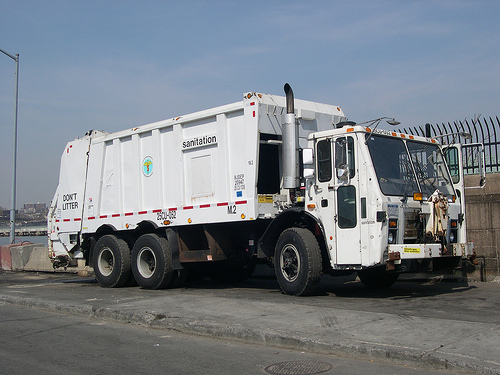Another Man’s Treasure

Every day, we throw out lots of stuff. Some if it is clearly waste — empty milk cartons, discarded apple cores, that shattered toy that’s now missing both arms and a leg. Other stuff, though, may be worth something to someone else, but it’s not worth our time and effort to find a new home for that item. It makes its way into the garbage pail and, ultimately, into the municipal sanitation system, just like that now-empty banana peel from breakfast.
When it gets there — if you’re in New York City, at least — it may catch the eye of a sanitation worked named Nelson Molina. And if it does, what you thought was destined for the landfill may actually be sitting in the second floor of a New York City Sanitation Department garage in Manhattan.
A dozen or so garbage trucks are parked at the garage on 99th Street between First and Second Avenues in the New York borough which is home to Central Park, Times Square, and many other well-known city locations. Up in that neighborhood, if you go a few blocks west to Fifth Avenue, you’ll hit what’s known as “Museum Mile,” a twenty to thirty-block long stretch featuring nearly a dozen museums, including the Guggenheim and the Metropolitan Museum of Art. But to find the Trash Museum — unofficially named, of course — one need not get on the crosstown bus. Just go into the garage and up to the second floor.
Molina, a trash collector now approaching 60 years of age, picks up refuse in the neighborhood and has for years. A life-long sanitation worker, he decided in 1981 to bring some cheer to the locker room, decorating it with a few items he found along his route. As the New York Times reported, this started some sort of trend: “his colleagues on East 99th Street began to contribute, gathering up discarded gems they thought he might enjoy. As the collection grew, word spread, and workers from other boroughs started to drop off contributions from time to time. Next, building superintendents along Mr. Molina’s route started putting things aside they thought he could use.”
Over the course of two decades, Molina, the de facto curator, has collected somewhere in the realm of 1,000 items for the Trash Museum. (Many more things have been dropped off, but Molina is the ultimate arbiter as to what trash is worthy for inclusion and which items are, well, truly trash.) Items are grouped by some sort of common aesthetic, as determined by Molina, and there are no rules for inclusion — Molina told the Times that “he has no grand theories about what qualifies, [. . .] only his gut.” One assumes that there aren’t any half-eaten pastrami sandwiches, but there are plenty of baseballs, paintings, teapots, and more, as seen in this photo gallery.
The Sanitation Department’s rules prevent workers from taking anything discarded for personal use, but that apparently doesn’t apply in this case, as the museum’s collection is on display for the benefit and enjoyment of others, and not Molina himself.
Bonus fact: In 2010, the city of Cleveland, Ohio, outfitted curbside recycling bins with RFIDs — radio frequency identification chips — to allow them to determine how often a bin is brought out. Pickup is weekly, and if the bins aren’t brought out often enough, trash collectors can inspect the regular trash bins left by residents to see if recyclables are included.
From the Archives: Garbage City: A city in Egypt that runs on trash.
Related: Want to become a New York City sanitation worker? You need to pass an exam first. This book may help.
